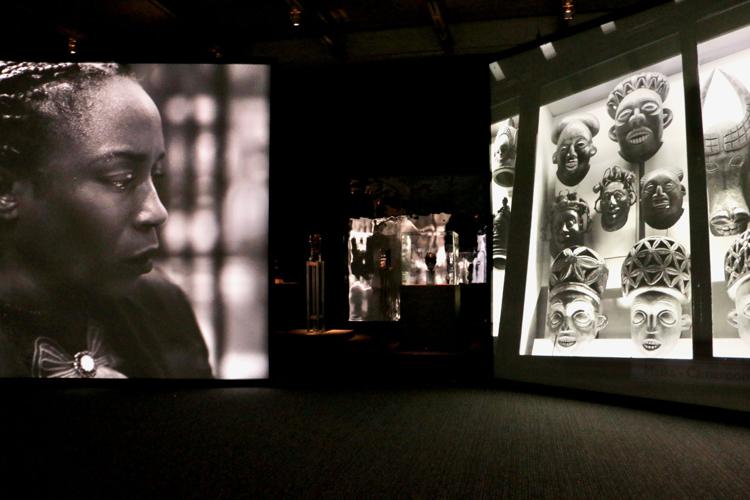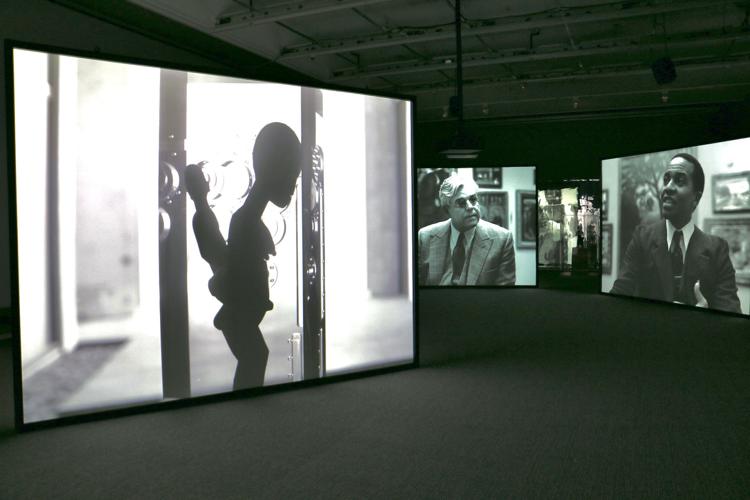The five projections of the new film installation, “Once Again…(Statues Never Die),” spends much of its screen time showing people quietly pondering art. Visitors to the Barnes Foundation temporary gallery will find themselves looking at people looking.
The walls of the gallery are hung with reflective polystyrene panels. As visitors walk around and between the arrangement of large-scale screens, the perspectives multiply.
“There is this doubling of looking that’s taking place,” said artist Isaac Julien. “They’re the kinds of things that you can do which make installations of moving images unique, as opposed to when you’re in a cinema with a single screen.”
The Barnes commissioned Julien to make “Once Again” to mark the organization’s centenary. At the core of the film is the relationship between founder Dr. Albert Barnes and writer and intellectual Alain Locke. Both were born in Philadelphia, and both were champions of African art: one as a prominent collector, the other as the author of “The New Negro” and dubbed the Dean of the Harlem Renaissance.
Barnes and Locke were both very good at looking. Julien fabricated a debate between them using actors delivering excerpts from their respective published writings, wherein Barnes and Locke discuss the reasons African art should not be considered a cultural fetish or “primitive” fad, but rather a sophisticated and spiritual craft that holds its own against the contemporary Western art of the day.
On the perimeter of Barnes gallery outside the circle of light created by the film projections are several pieces of African art displayed under glass. Some of them have been altered by contemporary artist Matthew Angelo Harrison, who acquired carved West African figures and submerged them in epoxy resin. The figures can never be removed intact from their plastic block, thus explicitly divorcing the object from the original intention for which it was created.
“I think about African American artists like Matthew Harrison, and the way that he uses African art objects as a critique but also as a way to create a different type of looking,” said Julian. “I’m trying to think about a form of poetic restitution, where artists are involved in recuperating the gaze.”
“Once Again” was shot in various museum spaces, including the Barnes, the Pennsylvania Academy of the Fine Arts, and the Pitt Rivers Museum in Oxford, England, an archeological museum containing tens of thousands of pieces of African art and artifacts, some of which were acquired through British colonization.
Pitt Rivers has been the subject of criticism in the past for representing the legacy of British imperialism, and in recent years has been at the forefront of the museum sector’s effort to repatriate objects and broaden an appreciation for diverse cultural perspectives.
“For those who have heritage or roots in regions of the world that suffered the violence of Empire, the Pitt Rivers Museum can be a very difficult and hurtful place to be,” the museum acknowledged on its website.
In Julien’s film, Black visitors are seen walking among Pitt Rivers’ cases containing African art, engrossed by what they see. “Once Again” is less concerned about how those objects came to be on display behind glass in a British museum, and more about the power they wield for those who look at them in a particular way.
“Contemplating them, I feel, occasionally, totally detached from my surroundings,” says one of the characters in the film, a Black woman curator, borrowing from the writing of Nigerian playwright Wole Soyinka.
“They become kind of mediums of introspection,” she continues. “Some of the deities represented — like the god Ogun for instance — values his isolation. Ogun retreats in the hills and just steals away from humanity. This is a trait I discovered in myself.”
Looking, in Julien’s film, becomes a self-actualizing act of liberation. While Barnes and Locke discuss aesthetic philosophy in erudite tones, we see other characters enrapt by looking at African art, mindful of past cultural violence but whose gaze is compared to that of a lover.
“There are no pure ways of looking,” said Julien. “The entanglement of both desire and the way artworks signify sometimes escape the boundaries of discourses, which might dictate neat realignments of where things should be viewed and how they should be viewed. There’s always going to be transgression in terms of how we look at objects and artworks.”
In one of the final scenes of the film, a man stands alone in falling snow lamenting a lost lover. A voiceover describes a sadness laced with transcendence learned from looking at art.
“We will keep the knowledge of how to use our imagination as a vehicle to let all the worldly things go,” the man says. “As we mature as artists in the mythical, diasporic dream space, a culture of infinite possibility is ready to receive us. This is artistic freedom as pure and unsullied as falling snow.”
That speech is attributed to the writer bell hooks. Julien pulled together the narrative from many sources, with much of the dialogue and voice overs co-opted from a roster of other authors including Barnes, Locke, Soyinka, poet Langston Hughes, and passages from “Discourse on Colonialism” by Aimé Césaire, the postcolonial poet and politician from Martinique.
Julien said the film came together organically, inventing the story as he went along.
“When I’m making a work, to be quite honest, I’ve got an idea of what I’m doing but I actually don’t really want to know exactly what I’m doing,” he said. “When we’re shooting, we don’t know how it’s going to assemble itself in the edit. I kind of don’t want to know. I want to be surprised.”
“One Again…(Statues Never Die)” is 32:30, running on a constant loop at the Barnes Foundation. The installation ends September 14.














(0) comments
Welcome to the discussion.
Log In
Keep it Clean. Please avoid obscene, vulgar, lewd, racist or sexually-oriented language.
PLEASE TURN OFF YOUR CAPS LOCK.
Don't Threaten. Threats of harming another person will not be tolerated.
Be Truthful. Don't knowingly lie about anyone or anything.
Be Nice. No racism, sexism or any sort of -ism that is degrading to another person.
Be Proactive. Use the 'Report' link on each comment to let us know of abusive posts.
Share with Us. We'd love to hear eyewitness accounts, the history behind an article.